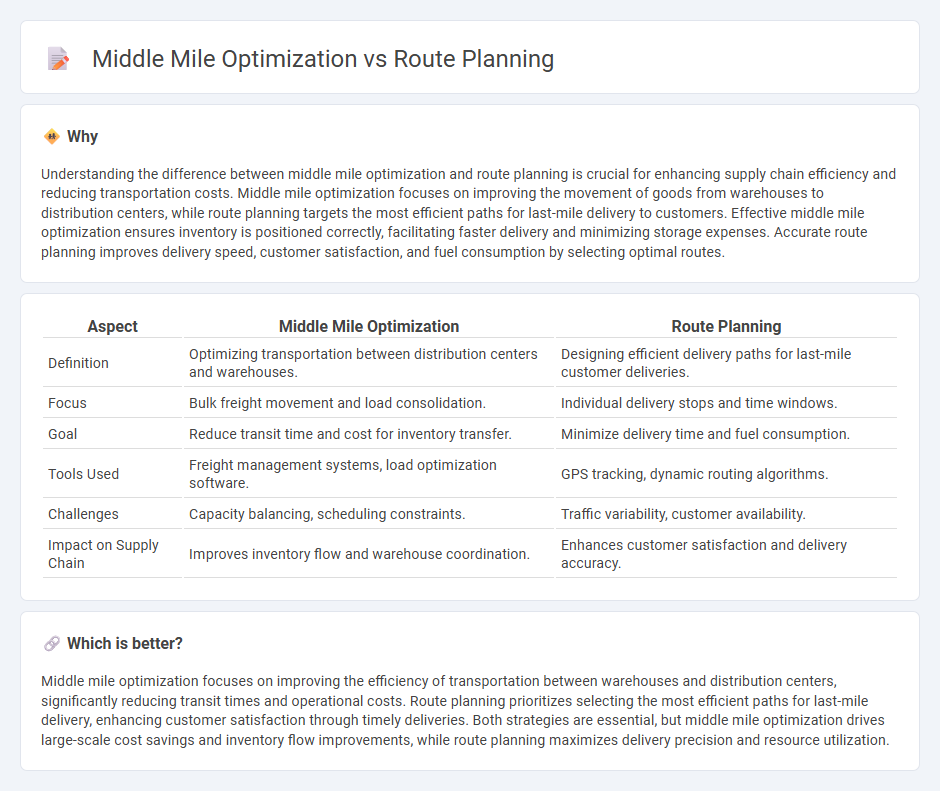
Middle mile optimization focuses on streamlining the transportation of goods between suppliers and distribution centers to reduce costs and improve efficiency. Route planning involves designing the most effective paths for delivery vehicles to ensure timely arrival and minimize fuel consumption. Discover how these strategies enhance supply chain performance and operational agility.
Why it is important
Understanding the difference between middle mile optimization and route planning is crucial for enhancing supply chain efficiency and reducing transportation costs. Middle mile optimization focuses on improving the movement of goods from warehouses to distribution centers, while route planning targets the most efficient paths for last-mile delivery to customers. Effective middle mile optimization ensures inventory is positioned correctly, facilitating faster delivery and minimizing storage expenses. Accurate route planning improves delivery speed, customer satisfaction, and fuel consumption by selecting optimal routes.
Comparison Table
| Aspect | Middle Mile Optimization | Route Planning |
|---|---|---|
| Definition | Optimizing transportation between distribution centers and warehouses. | Designing efficient delivery paths for last-mile customer deliveries. |
| Focus | Bulk freight movement and load consolidation. | Individual delivery stops and time windows. |
| Goal | Reduce transit time and cost for inventory transfer. | Minimize delivery time and fuel consumption. |
| Tools Used | Freight management systems, load optimization software. | GPS tracking, dynamic routing algorithms. |
| Challenges | Capacity balancing, scheduling constraints. | Traffic variability, customer availability. |
| Impact on Supply Chain | Improves inventory flow and warehouse coordination. | Enhances customer satisfaction and delivery accuracy. |
Which is better?
Middle mile optimization focuses on improving the efficiency of transportation between warehouses and distribution centers, significantly reducing transit times and operational costs. Route planning prioritizes selecting the most efficient paths for last-mile delivery, enhancing customer satisfaction through timely deliveries. Both strategies are essential, but middle mile optimization drives large-scale cost savings and inventory flow improvements, while route planning maximizes delivery precision and resource utilization.
Connection
Middle mile optimization improves route planning by enhancing the efficiency of transporting goods between distribution centers and retail locations, reducing transit times and costs. Advanced route planning algorithms leverage data from middle mile operations to identify optimal paths, minimize fuel consumption, and avoid bottlenecks. Integrating these processes boosts supply chain performance through timely deliveries and better resource utilization.
Key Terms
**Route Planning:**
Route planning involves determining the most efficient paths for transportation, minimizing travel time and fuel consumption while ensuring timely deliveries. It incorporates factors like traffic patterns, delivery windows, vehicle capacity, and road restrictions to optimize route efficiency. Explore our detailed insights to understand how advanced route planning can enhance your supply chain performance.
Shortest Path Algorithm
The Shortest Path Algorithm plays a crucial role in both route planning and middle mile optimization by identifying the most efficient routes to minimize travel time and fuel consumption. In route planning, it determines the quickest path for last-mile deliveries, while in middle mile optimization, it focuses on connecting distribution centers to retailers efficiently. Explore more to understand how these algorithms enhance logistics efficiency and reduce operational costs.
Real-time Traffic Data
Real-time traffic data enhances route planning by providing dynamic updates that adjust delivery paths to avoid congestion, reducing delays and fuel consumption. Middle mile optimization leverages this data to synchronize shipments between warehouses and distribution centers, ensuring timely transfers and cost efficiency. Explore how integrating real-time traffic insights can transform your logistics strategy for better performance and savings.
Source and External Links
RouteXL - Online route planner that finds the fastest itinerary for up to 20 stops, saving time, money, and fuel for couriers, sales teams, and logistics professionals.
MapQuest Route Planner - Optimizes multi-stop routes for up to 26 locations, allowing users to prioritize shortest time or distance and providing detailed directions and travel times.
MyRouteOnline - Google Maps-based route planner that optimizes driving routes for multiple destinations worldwide, offering import options and customizable planning goals.
 dowidth.com
dowidth.com